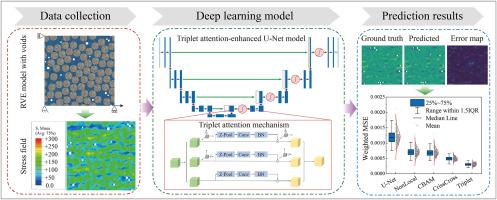A triplet attention-enhanced deep learning approach to predict full-field stress of unidirectional CFRP composites with microvoids
IF 9.8
1区 材料科学
Q1 MATERIALS SCIENCE, COMPOSITES
引用次数: 0
Abstract
Stress analysis is a critical step in composite material design. The high computational cost of multiscale finite element analysis necessitates the development of efficient surrogate modeling frameworks. To this end, this study develops a U-Net deep learning model enhanced with Triplet Attention mechanism for efficient prediction of full-field spatially nonlinear stress distribution in unidirectional CFRP composites with microvoids. Firstly, a Python based parametric modeling script is developed by integrating greedy and hard-core algorithms, enabling the construction of a microstructural database with randomly distributed voids and fibers. Then, the high-resolution stress field are computed by micromechanics-based finite element method. Subsequently, a U-Net architecture embedded with a Triplet Attention module is designed to improve the model's capability in extracting critical stress features. Finally, the proposed method is compared with several mainstream attention mechanisms including NonLocal, CBAM, and CrissCross using weighted MSE, MS-SSIM, R2, and SNR. The comprehensive evaluation demonstrates significant performance improvements over the traditional U-Net framework: Weighted MSE is reduced by 74.7 %, MS-SSIM improved by 4.7 %, R2 increased by 21.3 %, and SNR enhanced by 25.2 %. Further validation through varying dataset size and five-fold cross validation also confirms the model's reliability and robustness. This integrated approach simultaneously meets the technical requirements for computational efficiency, prediction accuracy, and engineering applicability in composite multiscale simulations, and thus provides a promising tool for applications in multiscale simulation, microstructural optimization, and uncertainty quantification.

基于三重注意力增强的深度学习方法预测微孔洞单向CFRP复合材料的全场应力
应力分析是复合材料设计的关键步骤。多尺度有限元分析的高计算成本要求开发高效的代理建模框架。为此,本研究开发了一种增强了三重注意机制的U-Net深度学习模型,用于有效预测单向微孔洞CFRP复合材料的全场空间非线性应力分布。首先,结合贪婪算法和硬核算法,开发了基于Python的参数化建模脚本,构建随机分布的孔洞和纤维微结构数据库。然后,采用基于细观力学的有限元方法计算高分辨率应力场。随后,设计了一个嵌入了三重注意力模块的U-Net架构,以提高模型提取关键应力特征的能力。最后,利用加权的MSE、MS-SSIM、R2和信噪比,将该方法与NonLocal、CBAM和criscross等几种主流注意机制进行了比较。综合评价表明,与传统的U-Net框架相比,加权MSE降低了74.7%,MS-SSIM提高了4.7%,R2提高了21.3%,信噪比提高了25.2%。通过不同数据集大小和五倍交叉验证的进一步验证也证实了模型的可靠性和稳健性。该综合方法同时满足复合材料多尺度模拟对计算效率、预测精度和工程适用性的技术要求,为复合材料多尺度模拟、微结构优化和不确定度量化等方面的应用提供了一种很有前景的工具。
本文章由计算机程序翻译,如有差异,请以英文原文为准。
求助全文
约1分钟内获得全文
求助全文
来源期刊

Composites Science and Technology
工程技术-材料科学:复合
CiteScore
16.20
自引率
9.90%
发文量
611
审稿时长
33 days
期刊介绍:
Composites Science and Technology publishes refereed original articles on the fundamental and applied science of engineering composites. The focus of this journal is on polymeric matrix composites with reinforcements/fillers ranging from nano- to macro-scale. CSTE encourages manuscripts reporting unique, innovative contributions to the physics, chemistry, materials science and applied mechanics aspects of advanced composites.
Besides traditional fiber reinforced composites, novel composites with significant potential for engineering applications are encouraged.
 求助内容:
求助内容: 应助结果提醒方式:
应助结果提醒方式:


